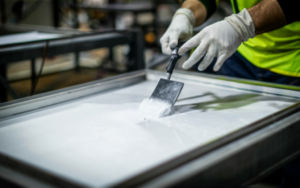Silk screening powder coating is a process that combines the art of silk screen printing with the application of a durable, protective powder coat. This technique enhances the appearance and longevity of various products, from automotive parts to household appliances. If you’re a beginner looking to explore this fascinating world, you’ve come to the right place. This comprehensive guide will provide you with an overview of the essentials of silk screening powder coating, including techniques, materials, and application processes.

1. Silk Screening Techniques:
Silk screening, also known as screen printing, is a versatile and widely used technique in the printing industry. It involves transferring a design onto a surface using a stencil and ink. Here are the basics of silk screening:
a. Screen Preparation: The first step in silk screening is to create a stencil, or screen. This is done by stretching a fine mesh fabric over a frame, coating it with a photosensitive emulsion, and exposing it to light with the design in place. Once the unexposed emulsion is washed away, the screen is ready for printing.
b. Ink Selection: Choose the appropriate ink for your project based on factors such as the type of material being printed on and the desired finish. For silk screening powder coating, a specialized powdered ink is used to create a durable, weather-resistant finish.
c. Printing: The screen is placed on the surface to be printed, and ink is applied to the screen using a squeegee. The ink passes through the open areas of the stencil, transferring the design onto the surface.
2. Powder Coating Materials:
Powder coating is a process that involves applying a dry, powdered paint to a surface and then curing it with heat. The resulting finish is highly resistant to chipping, scratching, and fading. The primary materials used in powder coating are:
a. Powder: Powder coatings are made from a blend of resins, pigments, and additives. They come in various colors, textures, and finishes, giving you plenty of options for customization.
b. Equipment: Essential powder coating equipment includes a powder spray gun, powder booth, and curing oven. The spray gun applies an electrostatic charge to the powder, causing it to adhere to the surface. The booth contains and recycles excess powder, while the curing oven heats the coated object to cure the powder.
3. Application Process:
When it comes to silk screening powder coating, the process combines the techniques and materials from both silk screening and powder coating. Here’s an overview of the application process:
a. Silk Screen Printing: First, the silk screening process is used to apply the powdered ink onto the surface of the object. The object should be clean and free of any contaminants to ensure proper adhesion.
b. Curing: Once the powdered ink has been applied, the object is placed in a curing oven. The heat causes the powdered ink to melt and fuse, creating a smooth, durable finish.
c. Cooling and Inspection: After the curing process is complete, the object is allowed to cool before being inspected for quality. Any necessary touch-ups or corrections can be made at this stage.
Conclusion:
Silk screening powder coating is an innovative technique that offers the best of both worlds – the creative possibilities of silk screen printing and the durability of powder coating. By understanding the basics of techniques, materials, and application processes, beginners can confidently explore this exciting method and create stunning, long-lasting products. Whether you’re looking to enhance your current business offerings or embark on a new creative venture, silk screening powder coating is a skill worth mastering.
